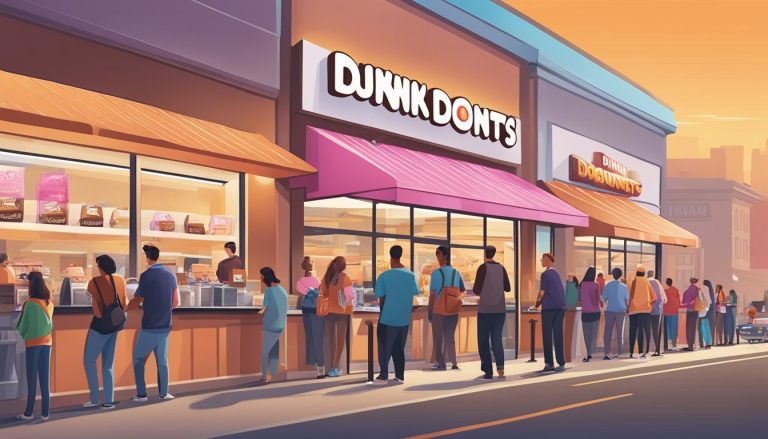Dunkin’ Donuts, a beloved American breakfast institution, has woven itself into the fabric of local economies across the nation. The iconic chain’s presence extends far beyond serving coffee and donuts, influencing job markets, supply chains, and consumer spending patterns in communities large and small.
The economic ripple effects of Dunkin’ Donuts’ operations are substantial, with each franchise location typically creating 20-30 direct jobs and supporting numerous indirect positions through its supply chain and complementary services. This job creation contributes to local economic growth and stability, providing employment opportunities for a diverse workforce.
Dunkin’ Donuts’ impact on local economies also manifests through its responsiveness to market conditions. The company has demonstrated adaptability in the face of economic fluctuations, adjusting its menu offerings and pricing strategies to meet changing consumer demands. This flexibility not only ensures the chain’s continued success but also helps maintain a steady flow of economic activity in the communities it serves.
Dunkin’s Economic Footprint

Dunkin’ Donuts has a significant impact on local economies through its extensive franchise network and employment opportunities. The company’s business model and supply chain management contribute to economic growth in communities across the United States and internationally.
Contribution to Local Economies
Dunkin’ Donuts stimulates local economies through its franchise model. Each franchise location generates tax revenue and supports other local businesses through supply chain purchases. The company’s expansion strategy often involves repurposing existing commercial spaces, contributing to urban renewal efforts.
Dunkin’ franchises frequently partner with local suppliers, creating a multiplier effect in regional economies. This approach helps maintain freshness while supporting area producers and distributors.
The brand’s popularity attracts foot traffic to shopping centers and business districts, benefiting neighboring establishments. Dunkin’ locations often become community gathering spots, fostering social connections that can lead to increased economic activity.
Employment and Franchise Operations
Dunkin’ Brands creates numerous jobs through its franchise operations. Each store typically employs 10-15 people, ranging from entry-level positions to management roles. This provides employment opportunities for diverse skill levels and backgrounds.
The franchise model allows local entrepreneurs to become business owners, building wealth within their communities. Dunkin’ offers training and support to franchisees, promoting business skills development.
Franchisees often become involved in local business organizations and chambers of commerce, further integrating Dunkin’ into the economic fabric of communities. This involvement can lead to additional investments and economic initiatives.
Dunkin’s supply chain management practices create efficiencies that benefit franchisees and local economies. Centralized purchasing and distribution systems help franchises achieve economies of scale, potentially leading to more competitive pricing and increased profitability.
Influence on Local Food & Beverage Markets

Dunkin’ has significantly shaped local food and beverage markets across the United States. Its presence affects both competition dynamics and consumer preferences in breakfast and coffee segments.
Competition with Local Coffee Shops
Dunkin’ exerts substantial pressure on independent coffee shops. Its widespread locations and efficient service model challenge smaller establishments. Local cafes often struggle to match Dunkin’s pricing and convenience.
Many have adapted by focusing on specialty coffees and unique atmospheres. Some emphasize locally-sourced ingredients or artisanal baked goods to differentiate themselves. This competition has led to improved quality and variety in local coffee markets.
Dunkin’s expansion has also influenced real estate trends. Prime locations for coffee shops have become more competitive and expensive.
Impact on Breakfast Food Sales
Dunkin’ has reshaped breakfast food sales in many communities. Its menu of coffee, donuts, and breakfast sandwiches has set new standards for quick-service breakfast options.
Local bakeries have seen shifts in demand. Some report decreased donut sales, while others have pivoted to offer more diverse pastry selections. Grocery stores have also adjusted their breakfast offerings to compete.
Dunkin’s success has prompted other chains like McDonald’s and Starbucks to expand their breakfast menus. This has led to increased variety and competition in the breakfast food market.
The company’s focus on convenience has influenced consumer expectations. Many now seek faster, on-the-go breakfast options, impacting traditional sit-down breakfast establishments.
Dunkin’s Role in Local Business Development
Dunkin’ plays a significant part in stimulating local economies through its franchise model and supply chain. The company’s presence creates opportunities for entrepreneurs and fosters partnerships with local businesses.
Stimulating Supplier Markets
Dunkin’ franchises rely on a network of local suppliers for ingredients, equipment, and services. This demand supports jobs and economic activity in surrounding communities. Local bakeries often partner with Dunkin’ to produce donuts and baked goods, boosting their operations.
Farmers and food producers benefit from contracts to supply coffee beans, dairy, and other raw materials. Packaging companies, equipment manufacturers, and maintenance services also see increased business. This ripple effect strengthens regional supply chains and encourages innovation among suppliers to meet Dunkin’s quality standards.
Partnerships and Collaboration Opportunities
Dunkin’ franchises frequently collaborate with other local businesses, creating mutually beneficial relationships. Cross-promotions with nearby retailers can drive foot traffic and sales for both parties. Some locations partner with gas stations or convenience stores to offer combined services.
Community engagement initiatives, such as sponsoring local events or sports teams, help Dunkin’ integrate into the fabric of towns and cities. These efforts build goodwill and customer loyalty while supporting local causes. Franchisees often become active members of chambers of commerce and business associations, contributing to economic development discussions.
Brand Impact and Customer Relations

Dunkin’ has built a strong brand presence and cultivated deep customer relationships through strategic initiatives and targeted marketing efforts. These approaches have solidified Dunkin’s position in the breakfast market and fostered a loyal customer base.
Building a Loyal Customer Base
Dunkin’ has implemented several strategies to create and maintain a loyal customer base. The DD Perks loyalty program has been a cornerstone of these efforts. Members earn points on purchases, which can be redeemed for free beverages. This system encourages repeat visits and increases customer retention.
The program also allows Dunkin’ to collect valuable data on customer preferences and buying habits. This information is used to tailor promotions and offers to individual customers. For example, a coffee-only customer might receive a special offer for a breakfast sandwich.
Dunkin’ focuses on convenience and accessibility. Stores are strategically located in high-traffic areas, making it easy for customers to grab their morning coffee and breakfast. The brand’s mobile app further enhances convenience, allowing for quick ordering and payment.
Dunkin’s Marketing and Brand Identity
Dunkin’s marketing strategies emphasize its brand identity as a quick-service restaurant focused on coffee and breakfast items. The company’s 2019 rebranding, dropping “Donuts” from its name, reflected its expanded menu offerings beyond just donuts.
The brand’s marketing campaigns often highlight the quality and affordability of its products. Seasonal promotions and limited-time offers create excitement and drive customer engagement. These campaigns are promoted across various channels, including television, radio, and digital platforms.
Social media plays a crucial role in Dunkin’s marketing efforts. The brand maintains an active presence on platforms like Instagram, Twitter, and Facebook. It uses these channels to showcase new products, run contests, and interact directly with customers.
Dunkin’ also tailors its marketing to local preferences in different regions. This approach helps the brand resonate with diverse customer groups and maintain relevance in various markets.
Product Strategy and Menu Innovation

Dunkin’ regularly refines its product offerings to meet evolving consumer tastes while optimizing operational efficiency. The company balances innovation with maintaining its core identity as a quick-service coffee and donut destination.
Adapting Offerings to Consumer Preferences
Dunkin’ has expanded beyond its traditional donuts and coffee to capture health-conscious customers. The menu now includes egg white sandwiches, oatmeal, and fruit-based smoothies. Premium coffee options like espresso drinks and cold brew have been added to compete with specialty coffee shops.
Seasonal limited-time offers, such as pumpkin-flavored items in fall, create buzz and drive traffic. Dunkin’ has also embraced plant-based trends, introducing almond milk as a dairy alternative and testing meat-free breakfast sandwiches in select markets.
Streamlining Menus for Economies of Scale
To improve speed of service and reduce complexity, Dunkin’ has streamlined its menu. The company eliminated less popular items and focused on core products like coffee, donuts, and breakfast sandwiches. This simplification allows for faster order fulfillment and more consistent quality.
Dunkin’ has invested in equipment upgrades to support menu innovations while maintaining efficiency. New brewing systems enable a wider range of hot and iced coffee options. The company has also standardized food preparation methods across locations to ensure consistency and reduce training costs.
Technological Advancements and Service Delivery

Dunkin’ has embraced digital technologies to enhance its operations and customer experience. These innovations have streamlined ordering processes and improved service delivery efficiency.
Mobile Ordering and Drive-Thru Efficiency
Dunkin’ introduced mobile ordering through its app, allowing customers to place orders ahead of time. This feature reduces wait times and improves accuracy.
The app integrates with Dunkin’s drive-thru system, enabling seamless pickup experiences. Customers can simply drive up and collect their pre-ordered items without delay.
Drive-thru lanes have been optimized with digital menu boards and order confirmation screens. These upgrades help minimize errors and speed up service.
Dunkin’ has also tested dedicated mobile order pickup lanes at select locations. This innovation further reduces congestion and waiting times for digital customers.
Leveraging Technology for Customer Experience
Dunkin’s loyalty program is fully integrated into its mobile app. Customers earn points on purchases and can redeem rewards directly through their smartphones.
The app provides personalized offers based on customer preferences and purchase history. This targeted approach enhances customer satisfaction and encourages repeat visits.
In-store kiosks offer another convenient ordering option. These self-service terminals reduce lines at the counter and allow for customized orders.
Dunkin’ continually updates its innovation pipeline to stay competitive. Recent tests include voice-activated ordering and artificial intelligence-powered suggestive selling.
These technological advancements have positioned Dunkin’ as a leader in quick-service restaurant digital integration. The focus on convenience and efficiency has strengthened customer loyalty and boosted sales.
Strategic Growth and Market Expansion

Dunkin’ has pursued aggressive growth strategies to expand its footprint domestically and internationally. The company leverages its franchise model and brand recognition to enter new markets strategically.
Domestic and International Market Strategies
Dunkin’ focuses on saturating existing markets while selectively entering new ones. In the U.S., the company targets areas with high population density and favorable demographics. It has expanded beyond its Northeast stronghold into the Midwest and West Coast.
Internationally, Dunkin’ adapts its menu and store designs to local tastes. The company has over 3,200 locations across 36 countries. Key growth markets include China, Brazil, and Germany. Dunkin’ partners with experienced local franchisees to navigate cultural differences and regulations.
The company’s franchise model allows for rapid expansion with lower capital requirements. This approach enables Dunkin’ to leverage local market knowledge and share financial risk.
Analyzing the Franchisee’s Perspective
Dunkin’ franchisees benefit from a proven business model and strong brand recognition. The initial investment ranges from $109,700 to $1,637,700, depending on location and store type.
Franchisees receive comprehensive training and ongoing support. This includes site selection, store design, and marketing assistance. The franchise agreement typically lasts 20 years.
Dunkin’s economies of scale provide franchisees with cost advantages in purchasing and advertising. However, franchisees must adhere to strict operational standards and pay ongoing royalties and fees.
The success of individual franchises varies based on location, management, and local market conditions. Franchisees must balance the benefits of a established brand with the costs and restrictions of the franchise model.
Corporate Social Responsibility and Sustainability

Dunkin’ Brands has made significant strides in implementing sustainability initiatives and contributing to local communities. The company’s efforts focus on responsible sourcing, environmental protection, and supporting farming communities worldwide.
Sustainability Initiatives in the Coffee Industry
Dunkin’ has partnered with the Rainforest Alliance to promote sustainable coffee farming practices. Since 2010, the company has granted over $260,000 to fund projects that help farmers increase profitability and productivity.
The brand has also committed to sourcing 100% sustainable coffee by 2025. This initiative aims to improve the livelihoods of coffee farmers while reducing environmental impact.
Dunkin’ has implemented programs to reduce waste in its supply chain. The company is working towards more sustainable packaging solutions, including the use of recyclable materials.
Contributions to Community and Environment
Dunkin’ Brands has launched several programs to support local communities. The company’s franchisees often participate in charitable activities and fundraising events.
The brand has set targets to reduce its environmental footprint. These include:
- Improving energy efficiency in stores
- Reducing water consumption
- Implementing recycling programs
Dunkin’ has also focused on nutrition, offering healthier menu options to meet changing consumer preferences. The company regularly updates its product offerings to include more wholesome ingredients.
Through these initiatives, Dunkin’ aims to create a positive impact on both local economies and the environment while maintaining its brand identity as a responsible corporate citizen.
Financial Overview and Market Performance
Dunkin’s financial performance and market position reflect its strategy of offering affordable coffee and food options. The company has leveraged economies of scale and targeted promotions to drive sales growth in a competitive quick-service restaurant landscape.
Revenue Analysis and Profit Margins
In 2019, Dunkin’ Donuts generated $1.37 billion in global revenue. This figure underscores the brand’s significant market presence, particularly in the coffee and breakfast segments. Dunkin’s pricing strategy focuses on affordability, with a large latte priced at $2.49, positioning it as a cost-effective option compared to competitors.
The company’s “Dunkin’ Deals” initiative, which bundles food items with coffee purchases, has helped maintain sales during economic downturns. This approach supports franchise owners while appealing to budget-conscious consumers.
Understanding the Competitive Landscape
Dunkin’ faces stiff competition from industry giants like Starbucks and McDonald’s. Despite Starbucks’ market dominance, Dunkin’ has carved out a niche by emphasizing value and convenience. The brand’s SWOT analysis reveals strengths in brand recognition and a wide-ranging menu.
Challenges include limited product innovation and the impact of external factors like the COVID-19 pandemic, which led to an 18.7% decrease in same-store sales in Q2 2020. To address these issues, Dunkin’ continues to focus on its core offerings while exploring new marketing strategies to drive customer engagement and sales growth.




